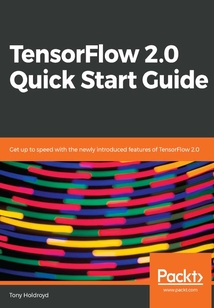舉報 

會員
TensorFlow 2.0 Quick Start Guide
TensorFlowisoneofthemostpopularmachinelearningframeworksinPython.Withthisbook,youwillimproveyourknowledgeofsomeofthelatestTensorFlowfeaturesandwillbeabletoperformsupervisedandunsupervisedmachinelearningandalsotrainneuralnetworks.Aftergivingyouanoverviewofwhat'snewinTensorFlow2.0Alpha,thebookmovesontosettingupyourmachinelearningenvironmentusingtheTensorFlowlibrary.Youwillperformpopularsupervisedmachinelearningtasksusingtechniquessuchaslinearregression,logisticregression,andclustering.Youwillgetfamiliarwithunsupervisedlearningforautoencoderapplications.Thebookwillalsoshowyouhowtotraineffectiveneuralnetworksusingstraightforwardexamplesinavarietyofdifferentdomains.Bytheendofthebook,youwillhavebeenexposedtoalargevarietyofmachinelearningandneuralnetworkTensorFlowtechniques.
目錄(167章)
倒序
- coverpage
- Title Page
- Copyright and Credits
- TensorFlow 2.0 Quick Start Guide
- Dedication
- About Packt
- Why subscribe?
- Packt.com
- Contributors
- About the author
- About the reviewers
- Packt is searching for authors like you
- Preface
- Who this book is for
- What this book covers
- To get the most out of this book
- Download the example code files
- Download the color images
- Conventions used
- Get in touch
- Reviews
- Section 1: Introduction to TensorFlow 2.00 Alpha
- Introducing TensorFlow 2
- Looking at the modern TensorFlow ecosystem
- Installing TensorFlow
- Housekeeping and eager operations
- Importing TensorFlow
- Coding style convention for TensorFlow
- Using eager execution
- Declaring eager variables
- Declaring TensorFlow constants
- Shaping a tensor
- Ranking (dimensions) of a tensor
- Specifying an element of a tensor
- Casting a tensor to a NumPy/Python variable
- Finding the size (number of elements) of a tensor
- Finding the datatype of a tensor
- Specifying element-wise primitive tensor operations
- Broadcasting
- Transposing TensorFlow and matrix multiplication
- Casting a tensor to another (tensor) datatype
- Declaring ragged tensors
- Providing useful TensorFlow operations
- Finding the squared difference between two tensors
- Finding a mean
- Finding the mean across all axes
- Finding the mean across columns
- Finding the mean across rows
- Generating tensors filled with random values
- Using tf.random.normal()
- Using tf.random.uniform()
- Using a practical example of random values
- Finding the indices of the largest and smallest element
- Saving and restoring tensor values using a checkpoint
- Using tf.function
- Summary
- Keras a High-Level API for TensorFlow 2
- The adoption and advantages of Keras
- The features of Keras
- The default Keras configuration file
- The Keras backend
- Keras data types
- Keras models
- The Keras Sequential model
- The first way to create a Sequential model
- The second way to create a Sequential model
- The Keras functional API
- Subclassing the Keras Model class
- Using data pipelines
- Saving and loading Keras models
- Keras datasets
- Summary
- ANN Technologies Using TensorFlow 2
- Presenting data to an ANN
- Using NumPy arrays with datasets
- Using comma-separated value (CSV) files with datasets
- CSV example 1
- CSV example 2
- CSV example 3
- TFRecords
- TFRecord example 1
- TFRecord example 2
- One-hot encoding
- OHE example 1
- OHE example 2
- Layers
- Dense (fully connected) layer
- Convolutional layer
- Max pooling layer
- Batch normalization layer and dropout layer
- Softmax layer
- Activation functions
- Creating the model
- Gradient calculations for gradient descent algorithms
- Loss functions
- Summary
- Section 2: Supervised and Unsupervised Learning in TensorFlow 2.00 Alpha
- Supervised Machine Learning Using TensorFlow 2
- Supervised learning
- Linear regression
- Our first linear regression example
- The Boston housing dataset
- Logistic regression (classification)
- k-Nearest Neighbors (KNN)
- Summary
- Unsupervised Learning Using TensorFlow 2
- Autoencoders
- A simple autoencoder
- Preprocessing the data
- Training
- Displaying the results
- An autoencoder application – denoising
- Setup
- Preprocessing the data
- The noisy images
- Creating the encoding layers
- Creating the decoding layers
- Model summary
- Model instantiation compiling and training
- Denoised images
- TensorBoard output
- Summary
- Section 3: Neural Network Applications of TensorFlow 2.00 Alpha
- Recognizing Images with TensorFlow 2
- Quick Draw – image classification using TensorFlow
- Acquiring the data
- Setting up our environment
- Preprocessing the data
- Creating the model
- Training and testing the model
- TensorBoard callback
- Saving loading and retesting the model
- Saving and loading NumPy image data using the .h5 format
- Loading and inference with a pre-trained model
- CIFAR 10 image classification using TensorFlow
- Introduction
- The application
- Summary
- Neural Style Transfer Using TensorFlow 2
- Setting up the imports
- Preprocessing the images
- Viewing the original images
- Using the VGG19 architecture
- Creating the model
- Calculating the losses
- Performing the style transfer
- Final displays
- Summary
- Recurrent Neural Networks Using TensorFlow 2
- Neural network processing modes
- Recurrent architectures
- An application of RNNs
- The code for our RNN example
- Building and instantiating our model
- Using our model to get predictions
- Summary
- TensorFlow Estimators and TensorFlow Hub
- TensorFlow Estimators
- The code
- TensorFlow Hub
- IMDb (database of movie reviews)
- The dataset
- The code
- Summary
- Converting from tf1.12 to tf2
- Other Books You May Enjoy
- Leave a review - let other readers know what you think 更新時間:2021-06-24 16:02:26
推薦閱讀
- 后稀缺:自動化與未來工作
- 零起步輕松學單片機技術(第2版)
- 腦動力:Linux指令速查效率手冊
- 現代測控電子技術
- 網上沖浪
- Mastering VMware vSphere 6.5
- 水晶石精粹:3ds max & ZBrush三維數字靜幀藝術
- Lightning Fast Animation in Element 3D
- Machine Learning with Apache Spark Quick Start Guide
- 突破,Objective-C開發速學手冊
- Microsoft System Center Confi guration Manager
- 液壓機智能故障診斷方法集成技術
- 機床電氣控制與PLC
- C#求職寶典
- 傳感技術基礎與技能實訓
- 深度學習實戰
- 我的IT世界
- AlphaGo如何戰勝人類圍棋大師:智能硬件TensorFlow實踐
- 瘋狂Java實戰演義
- 智能儀器基礎
- KUKA工業機器人與西門子S7-1200 PLC技術及應用
- MicroStrategy Quick Start Guide
- 玩中學:樂高機器人入門(上冊) (中小學創客教育執委會推薦教材)
- Drupal 7 Multi Sites Configuration
- TensorFlow Machine Learning Projects
- AI賦能:驅動產業變革的人工智能應用
- Mastering PostgreSQL 12
- Excel 2007公式、函數與圖表應用
- 對抗機器學習:機器學習系統中的攻擊和防御
- 看圖學中文版Windows XP

